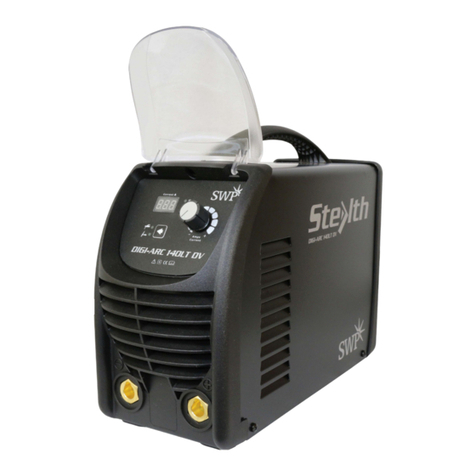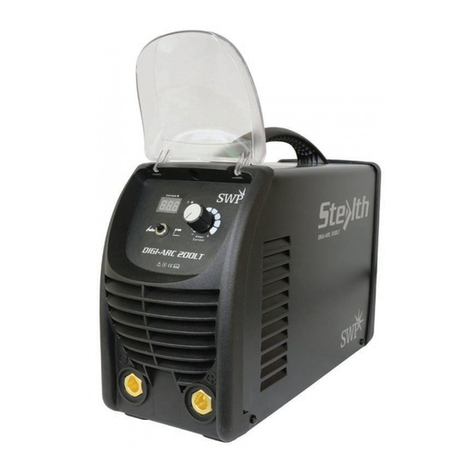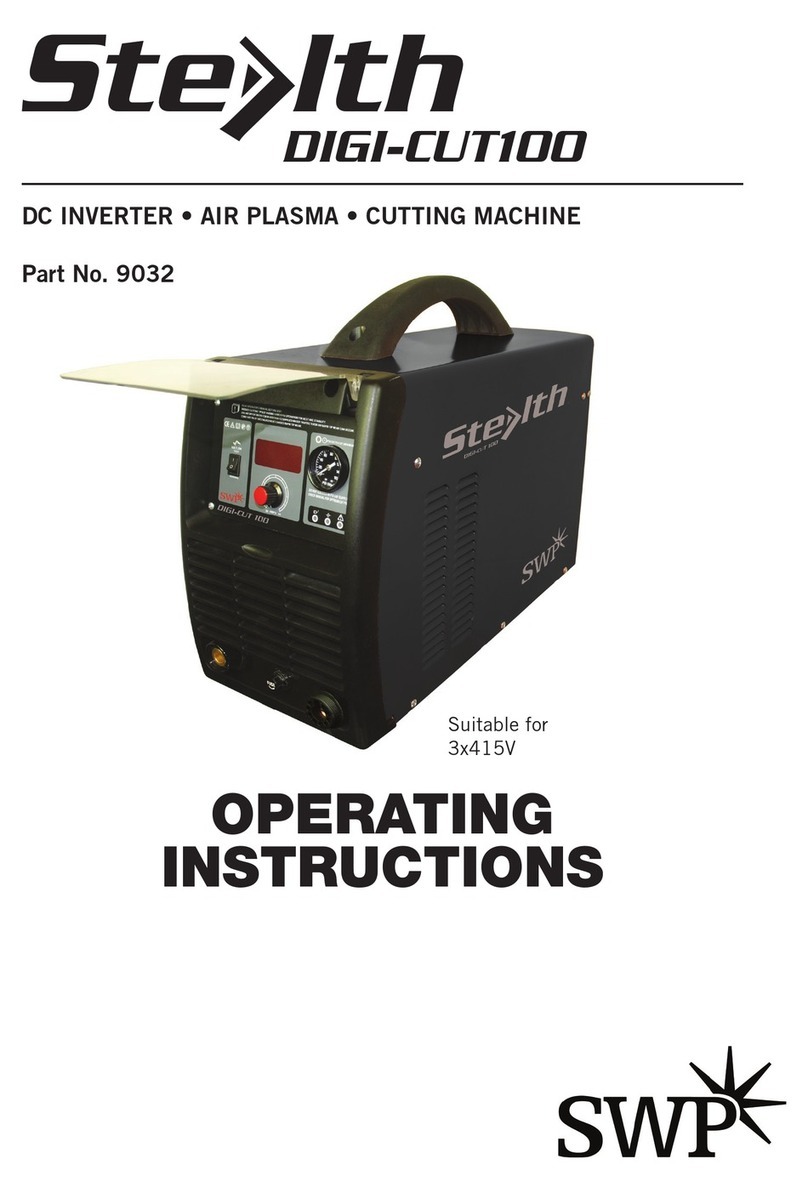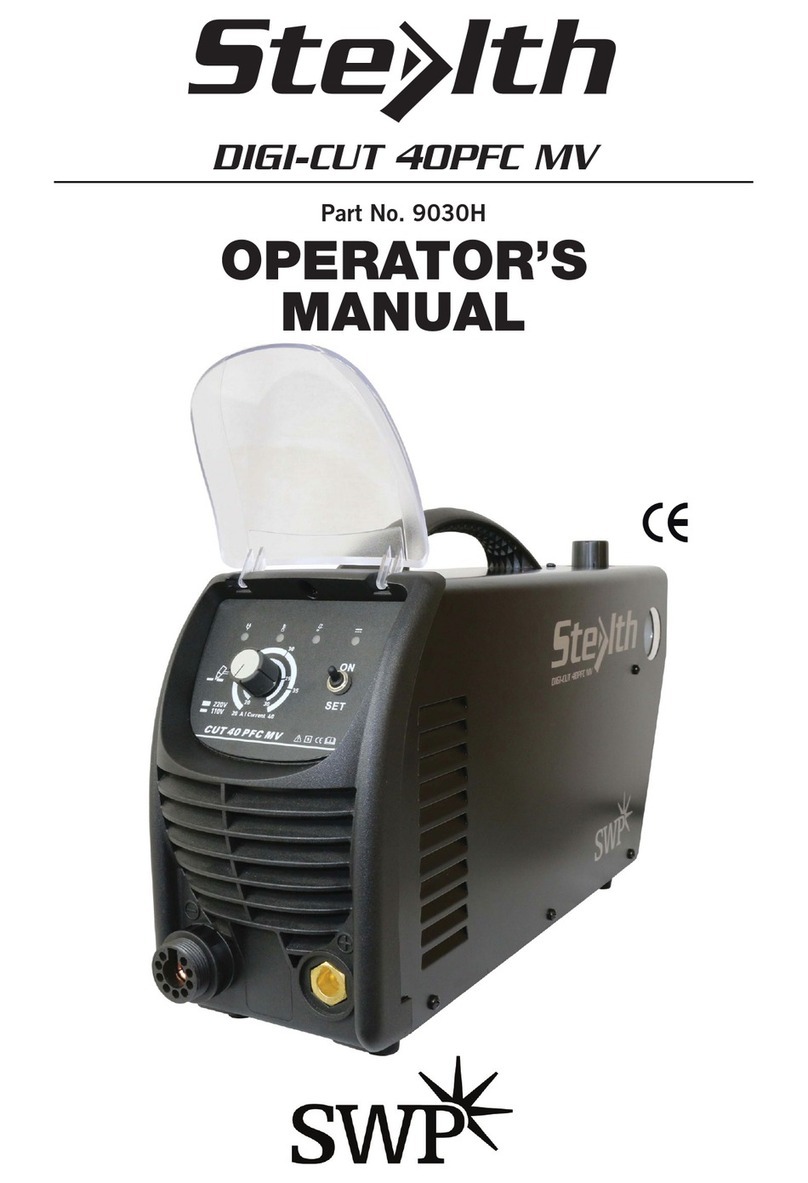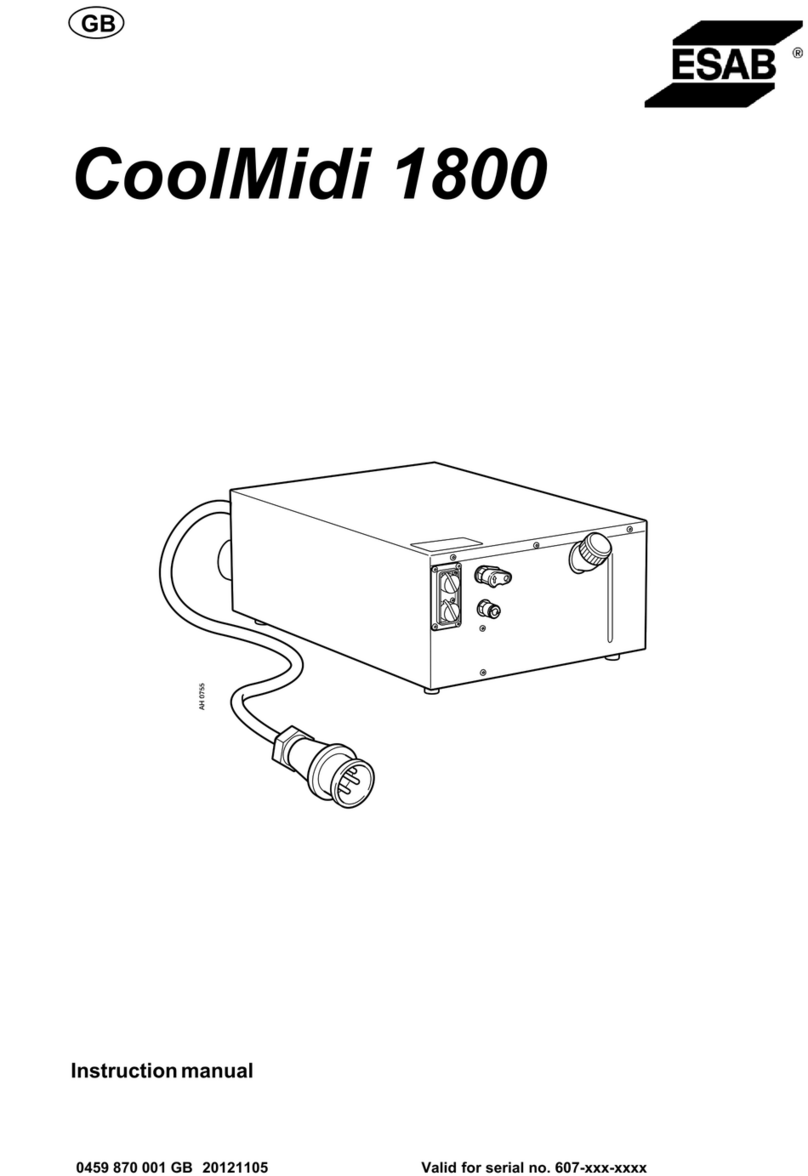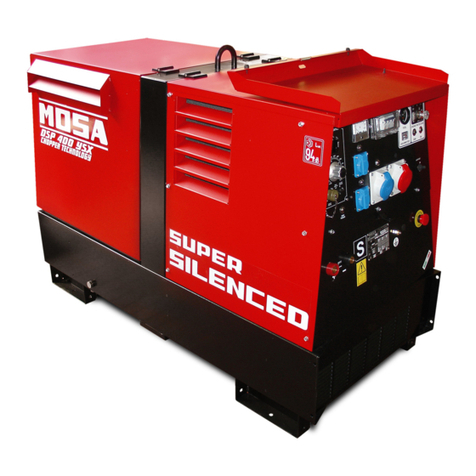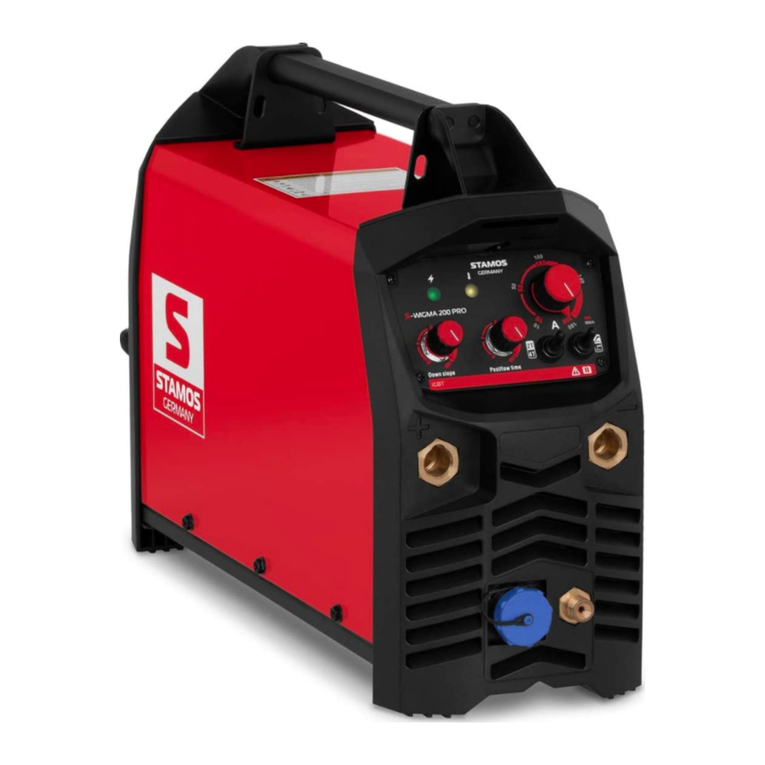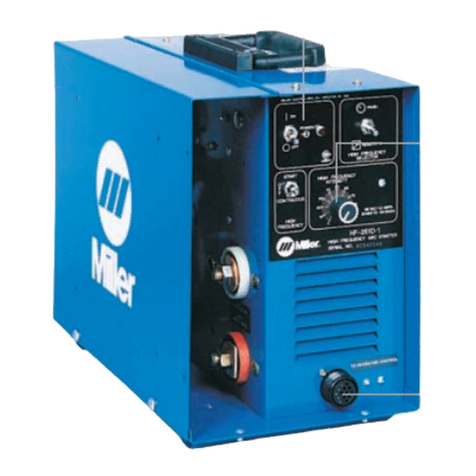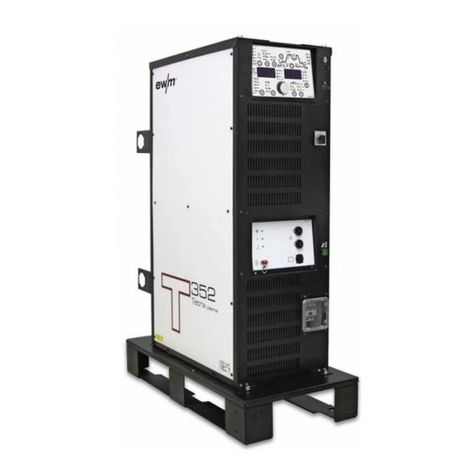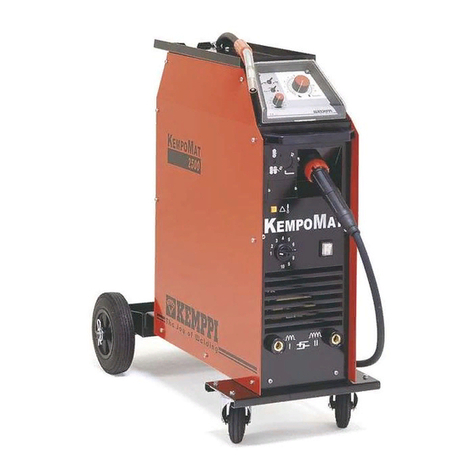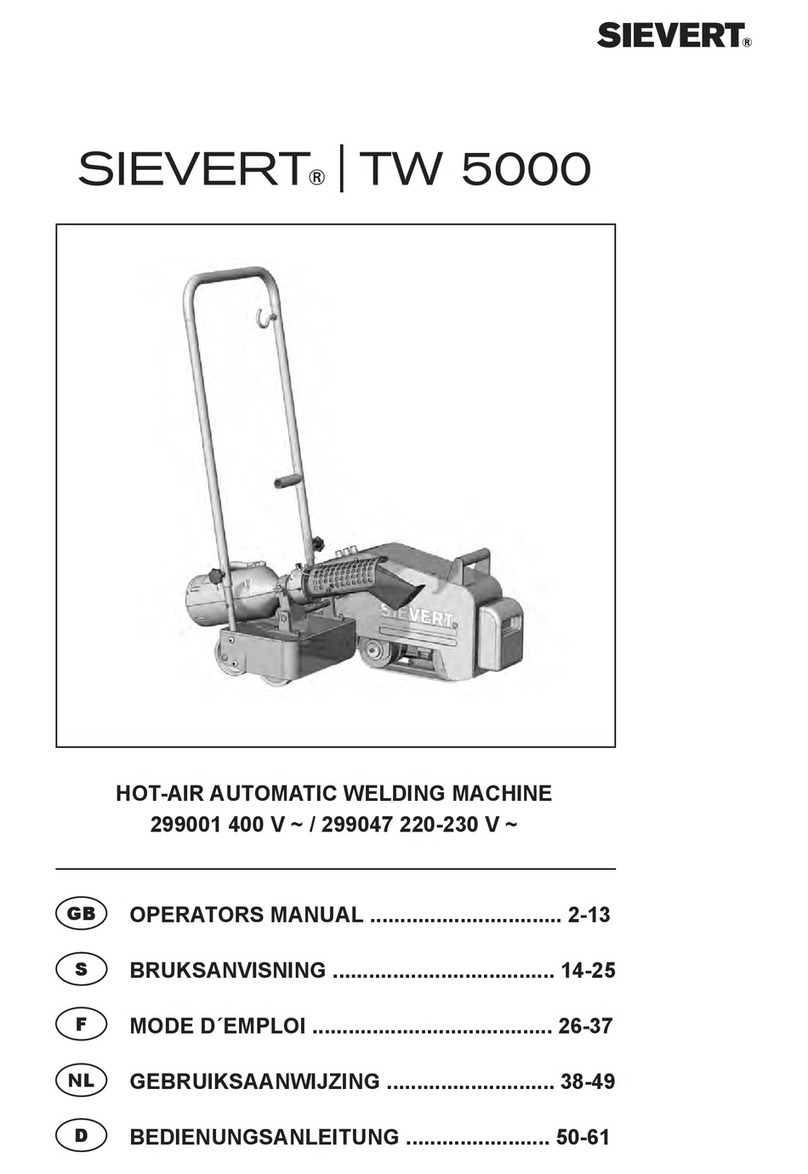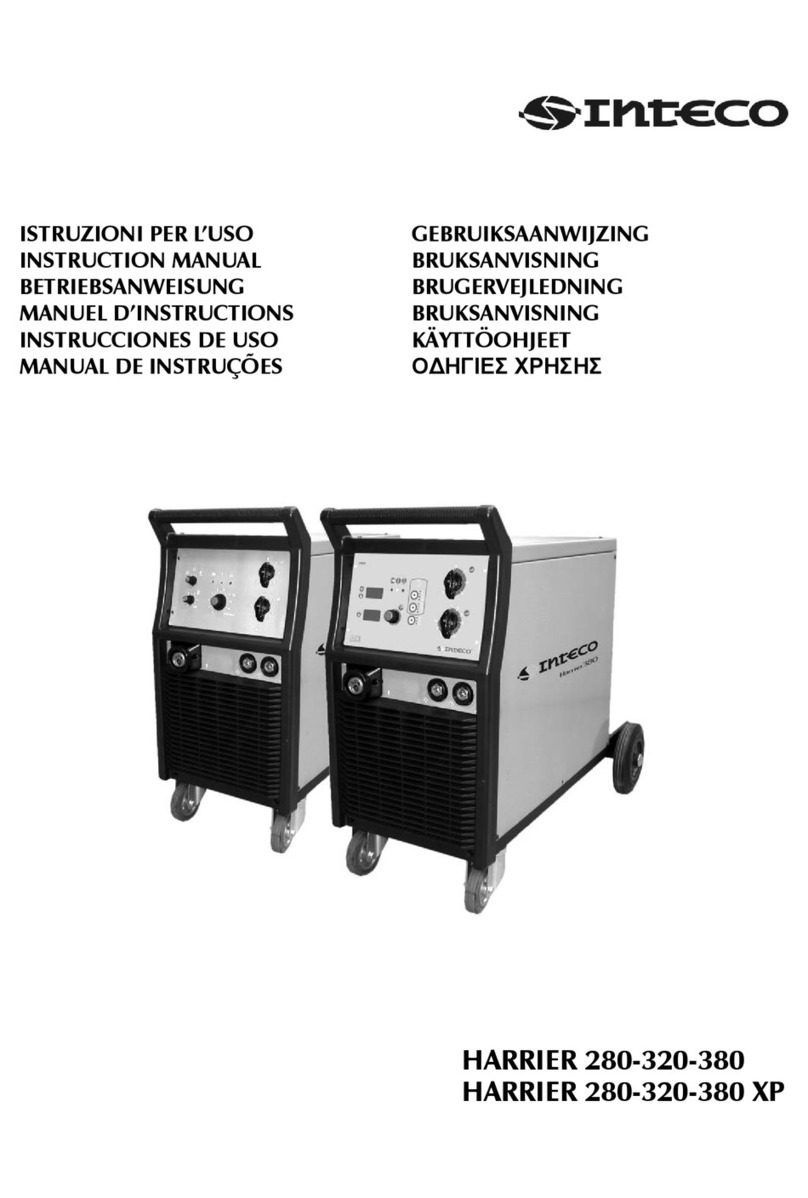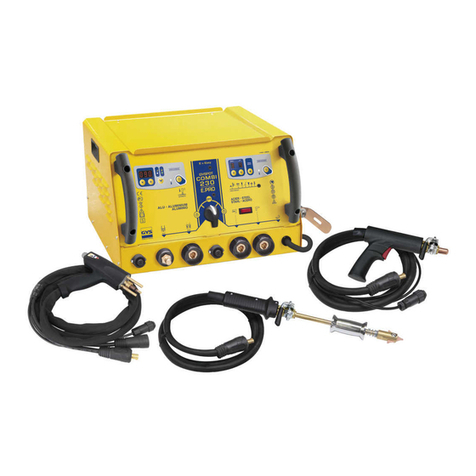SWP MIG 150 TURBO User manual

SWF
MM
51058-2010
2010-12
MIG-150
OPERATING
INSTRUCTIONS
A
Caution
Please
read
and
save
these instructions.
Read
carefullybeforeattempting
to
assemble,
install,
operates
or
maintains
the
productdescribed.Protectyourself
and
others
by
observing
all
safetyinformation.
Failure
to
complywithinstructionscouldresult
in
personal
injuryand/orproperty
damage!
Retain
instructions
for
futurereference.

Responsibility
The
usershall
inspect
the
equipment,
and
faulty
equipment
shall
be
stopped.
Allthe
faulted,
missed,abrasive,distorted
and
pollutedparts
shall
be
changedpromptly.Whenrepair
or
change,
the
manufactureradvised
the
user
to
change
the
partforward
the
require
in
written
or
callingform
to
the
licenseddistributors.
The
user
cannot
change
any
partswithout
the
manufacturesadvancedpermission,
Otherwise,
the
usershall
be
responsible
foranthe
accidents
caused
bythe
inappropriate
use.
Catalogue
Chapter/
Paragraph
Safety
Content
Safetywarning
Chapter
1
Productdescription
Chapter
2
Installing
Chapter
3
Operation
Chapter
4
Maintenance
Chapter
5
Troubleshooting
Chapter
6
Packinglist
Page
3
11
14
15
16

Safety
Warning
GENERALSAFETY
A
A
A
Danger
Warning
Qaution
Dangermeans
a
hazardthatwill causedeath
or
seriousinjury
if
the
warning
is
ignored.
Warningmeans
a
hazardthatcould causedeath
or
seriousinjury
if
the
warning
is
ignored.
Cautionmeans
a
hazardthat
may
causeminor
or
moderateinjury
if
the
warning
is
ignored.
It
also
may
mean
a
hazardthatwillonly
causedamage
to
property.
JJuk
BEJuSsffiS!
Improper
useof
electric
arc
welders
can
cause
electric
shock,
injury,
and
death!
Take
all
precautions
described
in
this
manual
to
reduce
the
possibility
of
electric
shock.
•
Verifythat
all
components
ofthearc
welder
are
clean
andin
good
condition
prior
to
operating
the
welder.
Be
surethat
the
insulation
onall
cables,electrodeholders,
and
power cords
isnot
damaged.Alwaysrepair
or
replacedamagedcomponentsbeforeoperating
the
welder.Always
keepwelderpanels,shields,etc.
in
placewhenoperating
the
welder.
•
Alwayswear
dry
protectiveclothing
and
weldinggloves,
and
insulatedfootwear.
•
Alwaysoperate
the
welder
ina
clean,
dry,well
ventilated
area.
Donot
operate
the
welder
in
humid,wet,
rainy,
or
poorlyventilatedareas.
•Be
surethat
the
workpiece
is
properlysupported
and
groundedprior
to
beginning
any
electric
arc
weldingoperation.
•
Coiledweldingcableshould
be
spread
out
before
useto
avoidoverheating
and
damage
to
insulation.
Electric
arc
welding
operations
produce
intense
light
and
heat
and
ultraviolet
(UV)
rays.
This
intense
light
and
UV
rays
can
cause
injury
to
eyes
and
skin.
Take
all
precautions
\d
in
thismanual
to
reduce
the
possibility
of
injury
to
eyes
and
skin.
•All
personsoperatingthisequipment
orinthe
areawhileequipment
isinuse
mustwear
protective
weldinggearincluding:weldinghelmet
or
shieldwithpropershade
as
specified
inthe
followingchart,flameresistantclothing,leatherweldinggloves,
and
fullfootprotection.
•
Neverlook
atarc
weldingoperationswithout
eye
protection
as
describedabove.Never
usea
shadefilterlensthat
is
cracked,broken,
or
ratedbelownumber
10.
Warnothers
inthe
area
notto
look
atthe
arc.

Safety
Warning
Electric
arc
welding
operations
causesparks
and
heatmetal
to
temperaturesthat
can
causesevere
burns!
Use
protectivegloves
and
clothing
whenperforming
any
metal
working
operation.Take
all
precautionsdescribed
in
this
manual
to
reduce
the
possibility
of
skin
and
clothing
burns.
•
Makesurethat
all
persons
inthe
weldingarea
are
protectedfromheat,sparks,
and
ultraviolet
rays.
Use
additionalfaceshields
and
flameresistant
barriers
as
needed.
•
Never
touch
workpieces
until
completelycooled.
£jk
'l^SliEjtiiil^
j
Heat
and
sparksproducedduringelectric
arc
welding
and
othermetalworkingoperations
can
ignite
flammable
and
explosive
materials!
Take
all
precautions
described
in
this
manual
to
reduce
the
possibility
of
flames
and
explosions.
•
Remove
all
flammablematerialswithin
35
feet
(10.7
meters)
of
weldingarc.
If
removal
isnot
possible,
tightlycoverflammablematerialswithfireproofcovers.
•Donot
operate
any
electric
arc
welder
in
areaswhereflammable
or
explosivevapors
maybe
present.
Takeprecautions
tobe
surethatflying
sparks
and
heat
donot
causeflames
in
hidden
areas,
cracks,behindbulkheads,etc.
Do
not
breathe
fumes
that
are
produced
by
the
arc
weldingoperation.Thesefumes
are
dangerous.
Ifthe
welding
area
cannot
be
adequatelyventilated,
be
sure
tousean
air-supplied
respirator.
•
Keep
the
head
and
face
outofthe
weldingfumes.
•Donot
performelectric
arc
weldingoperations
on
metalsthat
are
galvanized
or
cadmium
plated,
or
containzinc,mercury,
or
berylliumwithoutcompleting
the
followingprecautions:
a.
Remove
the
coatingfrom
the
basemetal.
b.
Makesurethat
the
weldingarea
is
wellventilated.
c.Usean
air-suppliedrespirator.
Extremely
toxicfumes
are
createdwhenthesemetals
are
heated.
The
electromagneticfieldthat
is
generated
during
arc
welding
may
interferewith
the
operation
of
various
electricai
and
electronicdevicessuch
as
cardiacpacemakers.
Persons
usingsuchdevicesshouldconsult
with
theirphysician
prior
to
performing
any
electric
arc
welding
operations.

Safety Warning
•
Neverwrap
arc
weldercablesaround
the
body.
•
Alwaysposition
the
electrode
and
groundleads
so
thatthey
areonthe
sameside
ofthe
body.
•
Exposure
to
electromagneticfieldsduringwelding
may
haveotherhealtheffectswhich
arenot
known.
A
Warning
Equipment
maintenance—The
wrong
or
inappropriate
equipment
maintenance
can
cause
injury
or
death.
•The
licensedpeople
cando
assembly,maintenance
and
someotheroperation.
•The
powersourceshall
be
turned
off
when
any
maintenancework
inthe
powersourceneeded.
•
Endure that
the
cable,earthwire,connector,mainlead
and
power
supply
areinthe
normal
work.
•Donot
abuseequipments
and
firing.
•
Keep
the
safeequipment
and
cabinetshall
in
peace
and
goodcondition.
•Donot
change
any
equipment.

Chapter
1
Product Description
1.1
Produceapplication
MIG
seriesweldingmachineadoptspecialtappedtransformeradjustingstyle.
Itisthe
economical
and
practicalmechanicalproducts,
ithas
wire-feedsystem,smallvolume,easy
to
shift
and
simpleoperation,
it
applies
to
weldingmildsteel,low-alloysteel
andsoon.
1.2
Modelunit
~~
-----.
^JVSpdel
Item
^~~~
—
-—•—__
Rated
input
voltage
Frequency
Phase
Max.
Inputcurrent
No-loadvoltage(peakvalue)
HeatSetting
Ratedoutputcurrent
Ratedoutputvoltage
*Duty
cycle
Insulationgrade
Usable
wire
Weight
Dimension(LxWXH)
MIG-150
230V
50Hz
Single
20A
25-45VDC
MIN,
1
MAX,
1
30A
75A
15.5V
17.8V
100%
25%
MAX,
2
105A
19.2V
15%
H
0.8mm
or
0.9mmfluxcorewire;
0.6mm
to
0.8mmsteelwire
26.2Kg
43cm
X
27cm
X
34.
5cm
*Duty
cycle
isthe
ratio
ofthe
uninterruptedon-loadduration
tothe
totaltime
(10
minutes
here).
It
liesbetween
0 and
1,
andcanbe
expressed
asa
percentage.
For
example,
inthe
case
of
a
60%
dutycycle,
a
load
is
applied
continuously
for6
min
followed
bya
no-loadperiod
of4
min.
Note;
1.The
heatingtest
ofthe
weldingpowersource
is
carried
outat
ambient
temperature.
Dutycycle
at40'C
has
beendetermined
by
simulation.
2.
The
weldingpower sourcebelongs
to
Group
2 and
Class
B ISM
equipment
according
to
CISPR
11:2003.
1.3
Environmentalcondition
a)
Range
ofthe
temperature
ofthe
ambient
air:
Duringwelding:
—10°C
to
+4CTC
After
transport
and
storage
at:
—251;
to
+55"C
b)
Relative
humidity
ofthe
air:
Upto50%at
40°C
Upto90%at
20"C
c)
Ambient
air,
freefromabnormalamounts
of
dust,acids,corrosivegases
or
substances
etc.
other
thanthosegenerated
bythe
weldingprocess.
d)
Altitudeabove
sea
level
upto
1000m.
6

Chapter
1
Product
Description
e)
Base
ofthe
weldingpowersourceinclude
upto
15"
1.4
Voltagecharacteristic
and
currentcharacteristic
of
welding
power
The
curve
(as
diagram
1-1)
means
"V-A"
externalstaticcharacteristic
of
weldingpower,
gradient
of
curenamedslope,normalmeans "drop
off
voltage
per
100A".
The
curvesshow
the
outputvoltage
wecangetinany
presetoutputcurrentbecause
the
"V-A"slope
is
fixed.
50
100150200
MIG-150
externalstaticcharacteristic
I2(A)
250
Diagram
1-1
staticexternalcharacteristiccurve
1.5
Safety
Before
operating
the
equipment,
you
mustread
the
safetydirections
to
avoid
the
hurt
duetothe
inaccurate
and
improprietyinstalling.

Chapter
2
Installing
2.1
The
requirement
of
installingground
Equal
ground
is
necessary
tothe
machine,
the
groundmust
be
havegoodventilation
system,
and
can't
be
exposed
in
dust,dirt,
wetand
activesteam,
the
minimum
distancebetween
side
board
and
it'snearest
bar
must
5546cm
andthe
minimumdistance
between
backboard
and
it's
nearest
bar
must
5-46cm.
2.2
Check,discharged
and
placed
(1)
Afterreceiving
the
equipment,
you
shouldcheck
ifthe
equipment
has
beendamaged
during
traffic;
if
damaged,
you
shouldnotify
the
conveyances,
if
lackspareparts,please
notify
the
dealer
at
once.
(2)
Take
the
spareparts
out
frompackingbox,remove
the
packingmaterial,
and
check
ifany
cast
in
packingbox.
(3)
Checkeveryairway
inthe
shell,
and
makesurepacking
box
can'tblock
air
circulating.
(4)
Chooseroomyground
to
placedspareparts,
in
order
to
installingconveniently.
2.3
Installing
the
handle(Following
the
diagram
2-1)
1.
Place
the
handle
(1)
ontopofthe
cover.
2.
Secure
the
handle,using
the
screws(2).
Diagram
2-1
2.4
Wirespool
loading
NOTE:Thiswelder
can
weldusing
0.8rr,m
or
0.9mmFlux-Coredwire
(E71T-GS),
0.6mm
or
0.8mmsteelwire(E70S-6),wirespoolsize:
4"(102mm)
diameter.
1.
Verify
unit
isoffand
opendoorpanel
to
exposewirefeedmechanism.
2.
Unscrew
and
remove
the
wing
nut
(1)
andthe
spool
locking
knob
(2)
(see diagram2-2).
3.
Installwirespool
(3)
over
the
spool
axle
(4)and
onto
the
spring(5).
The
wire
onthe
spool
shouldunwindclockwise,
so
wire
can
come
off
spool
ontheend
closest
tothe
wirefeed
guidetube.
4.
Turn
the
spool
(3)by
hand whileslowlytightening
the
spool
locking
knob
(2)
until
a
light
drag
is
felt,
and
thentighten
the
wing
nut
(1)
up
against
the
spoollockingknob(2).
8

Chapter
2
Installing
.©
Diagram
2-2
2.5
Wirethreading
1.
Loose
and
lower
the
tensionadjustingknob(7),rotate
the
swing
arm(8)
awayfrom
the
wire
feeddriveroll(9).
Diagram
2-3
2.
Carefullydetach
theendofthe
wirefrom
the
spool(3).
To
prevent
the
spoolfrom
unwinding,maintaintension
onthe
wireuntilafterstep
5.
3.
Cutthe
wire
end
fromspool
and
straighten
the
first
4"
(100mm).
Donot
allow
wire
to
unravel.
Makesure
thecutendhasno
burrs
or
sharpedges(cutagain,
if
needed).
4.
Thread
the
wire
through
wirefeedguidetube(6),over
the
groove
in
drive
roll
(9)and
into
torch
tube.
5.
Close
the
swing
arm(8)and
latch
the
tensionadjustingknob
(7)in
place.Makesure
the
wire
is
positioned
inthe
groove
ofthe
driveroll.
6.
The
milled
nut
(10)
onthe
tensionadjustingknob
(7)
adjusts
the
pressure
onthe
wire.
Adjust
pressure
by
turning
the
milled
nut
(10)
until
smooth
and
easywire
feeding.
Start
with
the
pressure
settoan
intermediatevalue.Readjust,
if
necessary.Slightlyless
pressure
mayberequired.
Ifthe
driverollslipswhilefeedingwire,
the
pressureshould
be
increased
until
the
wirefeedsproperly.
7.
Removenozzle
(11)
by
turningclockwise,thenunscrewcontact
tip
(12)
from
endof
welding
torch(Seediagram2-4).Plugwelderinto
a
properpower supplyreceptacle.
8.
Turn
on
welder
andset
wirespeedrate
to6.Laythe
torchcable
outina
straightline
and
presstorchtriggeruntilwirefeeds
out
past
the
torchend.
Turn
welderoff.
9.
Carefullyslipcontact
tip
(12)
overwire
and
screw
tip
intotorchend.
Cut
wire
off
approximately
1/4
inchfromcontact
tip
end.
Install
nozzle
by
turningclockwise.
12
Diagram
2-4
9

Chapter
2
Installing
2.6
Connection
welder
togas
cylinder
Clean
the
threads
ofthegas
cylindervalve.Alsoopen
thegas
valve
fora few
seconds
to
blow
out
any
dirt
of
particulates
that
may
havegotteninto
the
richer
in
order
to
preventthemfrom
entering
the
regulator.Checkyourregulator(outletflowmeter:0-25L/Min,inletgauge:0-25Mpa,
pressure
range
for
safeoutpouring:
0-0.35Mpa)
to
makesurethat
itwas
suppliedwith
a
gasket.
Tighten
the
regulatorcoupling
tothe
cylinder
gas
valve.
Now
connect
the
welder
gas
line
tothe
hosebarboutlet
on
yourregulator;
a
stainlesssteelhose
clamp
canbe
used
to
insure
a
leak-proof
connection.(Seediagram2-5)
Check
all
connections
for
leaks
by
opening
the
regulator
and
cylinder
gas
valves.
Always
shut
offthe
regulator
and
cylinder
gas
valves
when
the
machine
isnotin
use.
REGULATOR
HOSE BARB
Diagram
2-5
10

Chapter
3
Operation
A
Cautions
Donot
operate
the
machinewhen
the
shell
has
beenopened,improper
cooling
can
damage
the
parts;makesure
the
sideboardhavebeenclosed.
Whenwelding,
you
mustwearhelmet,glove
and
otherguard.
3.1
Controls
and
component(diagram3-1)
7
Diagram
3-1
1.
Welder
2.
Torch
3.
Overloadlamp
4.
Powerswitch
5.
Wirespeedcontrol
6.
Amperageselectionswitch
7.
Groundingcable
8.
Powercord
3.2
Graphicsymbols
and
technical
data
U0
.....V
X
\2
...... A
U2
.....V
•
-A
IP21
This
symbolshows
the
secondaryno-loadvoltage
(in
volts).
Thissymbolshows
the
rateddutycycle.
Thissymbolshows
the
weldingcurrent
in
AMPS.
This
symbolshows
the
weldingvoltage
in
VOLTS.
Thissymbolshows
the
ratedsupplyvoltage.
Thissymbolshows
the
weldingunit'smaximumabsorbedcurrent
in
AMP.
Thissymbolshows
the
weldingunit'smaximumeffectivesupplycurrent
in
AMP.
This
symbolshows
the
weldingunit'sprotectionclass.
This
symbolshowsthat
the
weldingunit
is
suitable
forusein
environments
wherethere
isa
highrisk
of
electricshocks.
Thissymbolshowsread
the
operatinginstructionscarefullybeforeoperation.
This
symbolshows
a
singlephasetransformerrectifierwelder.
11

Chapter
3
Operation
^^•^
Thissymbolshows
the
supplypowerphase
and
linefrequency
in
Hertz.
1
"-
oUMZ
This
symbol
shows
the
welder
is
metalinert
and
active
gas
welding
including
theuseof
fluxcoredwire.
3.3
Operationprocess
Before
Welding
•
Read
and
understand
the
safetyrulessection
of
this
manual.
•Be
sure
all
flammablematerials
are
removed
the
workarea.
•
There
is
goodventilationaround
the
weldingunit
andthe
areathat
you
will
be
working.
•Be
sure
you
havefire-extinguisherready
in
case
ofan
accident.
•Puton
appropriateprotectiveclothing
and
insulatedleathergloves.
3.3.1
Use
withcoredwire
The
welder
can
usedwithspecialFluxwirethatdose
not
requireprotectivegas.Thiswire,
contrary
tothe
casewithelectrodes,does
not
leaveslag
and
givesbetterbreadpenetrationwith
substantially
lowerlineabsorption.
Makesure
youuse
properweldingpolarity:
as
diagram3-2B.groundingcableconnects
"+"
terminal,
anothercable(weldingtorchcable)
connect"-"
terminal.
GAS
I
ffl
NO
GAS
A
B
Diagram
3-2
Stepl:
Connectworkclampontometal
tobe
welded,
ortothe
metal
workbenchwhere
the
object
is
mounted
and
electricallyconnected.
Step2:
Before
plugging
in,
adjustamperage
and
wirefeedspeedaccording
to
materialtype
and
thickness,
andthe
wiresize.
StepS:
Check
the
powerswitch
isinOFF
position,
and
thenplug
the
powercordinto
its
electrical
outlet.
Step4:
Whileholding
the
Torchwith
the
wire
andtip
clearly
outofthewayofany
grounded
objects,
turn
the
powerswitch
toON
position.
StepS:
Orientyourself
onthe
area
tobe
welded,
and
thenplace
the
Face
Shield
overyour
eyes.
Warning:Neverlook
atthe
ignited
arc
withoutANSIapproved,
arc
shaded,
eye
protection
ina
full-faceshield.Permanent
eye
damage
or
blindness
can
occur.
Skin
burns
can
occur.
Never
breathe
arc
fumes.
StepG:
Press(andhold)
the
torchbutton
and
stroke
the
area
tobe
weldedwith
the
electrode
wire
to
ignite
the
arc.
Step7:Once
thearcis
ignited,
tilt
the
electrodewireforward
atan
angle
of
approximately
35°(as
diagram3-3).
StepS:
When
the
weld
is
complete,loose
the
torchbutton
and
lift
the
wire
clearlyawayform
any
groundobject,
setthe
FaceShielddown
and
turn
the
PowerSwitch
tothe
"OFF"position.
12

Chapter
3
Operation
Step9:
Unplug
the
PowerCord
fromthe
electricaloutlet.
Diagram
3-3
3.3.2
Use
mild
steelwire
The
welder
canuse
withmildsteelwire
and
shield
gasfor
weldingcarbonsteel.
The
shielding
gas
should
be
eitherpure
(100%)
COa
ora 75%
argon-25%
CO2
mixture.
Make
sure
youuse
properweldingpolarity:
as
diagram3-2A.groundingcableconnect
"-"
terminal,
anothercable(weldingtorchcable)
connect"+"
terminal.
The
diameter
ofthe
wire
you
select
shouldcorrespond
tothe
thickness
ofthe
work
piece.Makesurethat
the
contact
tipis
matching
the
size
ofthe
wirediameter.
Stepl:
Connectworkclampontometal
tobe
welded,
ortothe
metalworkbenchwhere
the
object
is
mounted
and
electricallyconnected.
Step2:Before
plugging
in,
adjustamperage
and
wirefeedspeedaccording
to
materialtype
and
thickness,
andthe
wiresize.
StepS:
Open
thegas
valve
of
regulator;press(and
hold)
the
torchtrigger
seta
flow
of5-7
L/Min
(depending
onthe
weldingpositionchosen).
Step4:Check
the
powerswitch
isinOFF
position,
and
thenplug
the
powercordinto
its
electrical
outlet.
Step5:
Whileholding
the
Torchwith
the
wire
andtip
clearly
outofthewayofany
groundedobjects,
turn
the
powerswitch
toON
position.
StepG:
Orientyourself
onthe
area
tobe
welded,
and
thenplace
the
FaceShieldoveryoureyes.
Warning:
Never
look
atthe
ignited
arc
without
ANSIapproved,
arc
shaded,
eye
protection
ina
full-face
shield.Permanent
eye
damage
or
blindness
can
occur.Skin
burns
can
occur.Neverbreathe
arc
fumes,
Step7:Press(andhold)
the
torchtrigger
and
stroke
the
area
tobe
weldedwith
the
electrodewire
to
ignite
the
arc.
StepS:
Once
thearcis
ignited,
tilt
the
electrodewireforward
atan
angle
of
approximately
35°(as
diagram
3-3).
Step9:When
the
weld
is
complete,loose
the
torchbutton
and
lift
the
wireclearlyawayform
any
ground
object,
setthe
Face
Shield
down
and
turn
the
Power
Switch
tothe
"OFF"position.
Stepl
0:
Unplug
the
PowerCordfrom
the
electricaloutlet.
Step
11:
Close
thegas
cylindervalve.
Stepl
2:
Depresstorchtrigger
to
release
gasin
regulator,
gas
pressure
indicatorwillreturn
to0.
A
Cautions
If
welding
with
largecurrent
fora
longtime
and
exceed
the
dutycycle,
the
overloadlampwii!light(yellow),
andthe
welderwill
turn
off
until
it
coolsdown.
If
thishappens,
you
must
stop
welding
and
wait
about
5
minutes,then
youcan
continue.
13

Chapter
4
Maintenance
A
Warning
Before
performing
any
maintenance
onthe
Welder,unplug
the
Power
Cord
from
the
electrical
outletand
allow
all
parts
ofthe
welder
to
cool
thoroughly.
1.
Periodicallyopen
the
AccessPanelfrom
the
unit
and,
usingcompressed
air,
blow
outall
dust
and
debris
from
the
interior.Inspect
allair
vents
and
cooling
slots
to
ensure
that
they
are
clean
and
unobstructed.
2.
Alwaysstore
the
Welder
ina
clean,
dry,
safelocation
outof
reach
of
children
and
other
unauthorizedpeople.
3.
For
optimalweldquality,clean
and
inspect
the
Contact
Tipand
Nozzlebeforeeach
use,
as
follows:
NOZZLEINSPECTION, CLEANING,
AND
REPLACEMENT
1.
Turn
the
Nozzlecounterclockwisewhilepulling
to
remove.
2.
Scrub
the
interior
ofthe
Nozzle
cleanwith
a
wirebrush.
3.
Examine
theendofthe
Nozzle.
Theend
should
be
flat
and
even.
Iftheendis
uneven,
chipped,
melted,cracked,
or
otherwisedamaged,
the
Nozzlewilladverselyeffect
the
weld
and
should
be
replaced.
4.
Reinstall
the
Nozzleafterinspecting
and
cleaning
the
Contact
Tip.
CONTACT
TIP
INSPECTION,CLEANING,
AND
REPLACEMENT
1.
Makesure
the
entireWeldingTorch
is
completelycoolbeforeproceeding.
2.
Remove
the
Nozzle
as
explainedabove.Thenremove
the
Contact
Tip.
3.
Scrub
the
exterior
ofthe
Contact
Tip
cleanwith
a
wirebrush.Checkthat
the
Contact
Tipisthe
proper
type
forthe
wire
size
used.
4.
Examine
the
hole
attheendofthe
Contact
Tipforthe
followingproblems:
The
holeshould
be
an
evencircle,
and
should
notbe
oblong
or
have
any
bulges
init;The
Contact
Tip
will
decrease
in
efficiency
asthe
centerholeenlarges.
5.
Ifany
problems
are
notedwith
a
ContactTip,
itis
recommended
to
have
it
replaced.
6.
Wheninspection
and
maintenance
is
completed,reinstall
the
Contact
Tipand
Nozzle.
14

Chapter
5
Troubleshooting
Warning
Be
CERTAIN
to
shut
offthe
welder,
disconnect
it
frompower,
and
discharge
the
torch
to
groundbeforeadjusting,cleansing,
or
repairing
the
unit.
Electricalrepairsshouldonly
be
made
by
trainedtechnician.
TROUBLESHOOTING
SymptomPossibleCauseCorrectiveAction
No
output
1.
Dutycycleexceeded
2.
Poor
work
clamp
connection
3.
Blownbreaker
or
fuse
1.
Allowwelder
to
cooluntillampgoes
out
2.Be
sure
ail
connections
are
secure,
and
attachingsurface
is
clean
3.
Reducecircuit
load,
resetbreaker
or
replacefuse
Wiretangles
at
drive
roller
1.
Wrongsizecontact
tip
2.
Torch
liner
clogged
or
damaged
3.
Contact
tip
clogged
or
damaged
4.
Driverollerworn
5.
Not
enough
tension
1.
Use
propersizecontact
tip
2.
Clean
or
replace
wire
liner
3.
Clean
or
replacecontact
tip
4.
Replacedrive
roller
5.
Tighten
tension
knob
Gun
nozzle
arcs
to
work
surface
1.
Slaginside
gun
nozzle
2.
Insulation
ring
melted
expired
or
1.
Cleanslagfrom
gun
nozzle
2.
Replace
nozzle
Work
clamp
and/or
cable
gets
hot
1.
Poorcontact
2.
Using
an
extensioncordwith
excessive
length
1.
Be
sure
all
connections
are
secure,
and
attachingsurface
is
clean
2.
Never
usean
extensioncordlongerthan
20ft
Wiredoes
not
feed
1.
Wirejammed
2.
Out
of
wire
3.
Not
enoughtension
4.
Wirelinerworn
5.
Contact
tip
clogged
1.
Reloadwire
2.
Replacewirespool
3.
Tightentensionknob
if
wire
is
slipping
4.
Replaceliner
5.
Replacecontact
tip
Weldpopsand
sputters
1.
Wirespeedsetting
2.
Contact
tip
size
too
large
3.
Polarity
set
incorrectly
4.
Driverollerslipping
5.
Gas
bottleempty
1.
Tune
in
correctsetting
2.
Replacecontact
tip
3.
Reversepolarity
4.
Increasetension
5.
Replace
gas
bottle
15

Chapter
6
Packing
list
Packing
list
No.
1
2
3
4
5
6
7
Name
Weldingpower
Operating
manual
Weldwire
Handle
Screw
Gas
hose
Hoseclamp
Specification
MIG-150
GB9074.4
M5X16
Qty
1
1
1
1
2
1
2
Remark
~
"
1
16
Table of contents
Other SWP Welding System manuals
Popular Welding System manuals by other brands
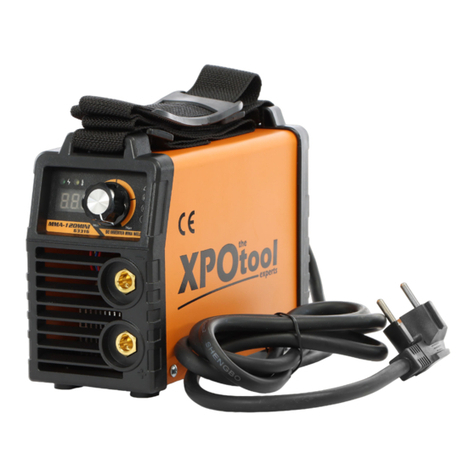
XPOtool
XPOtool 63316 user manual

Lincoln Electric
Lincoln Electric spirit II 150 Technical manual
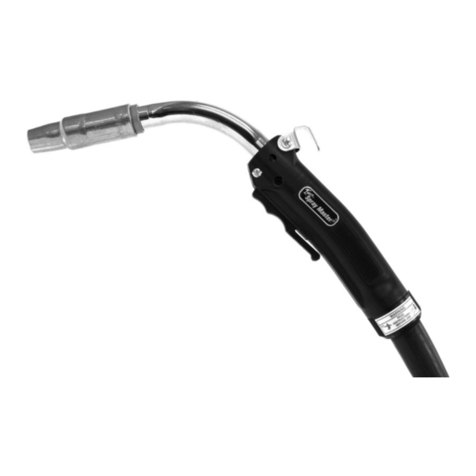
Tweco
Tweco Spray Master Series Safety and operating instructions
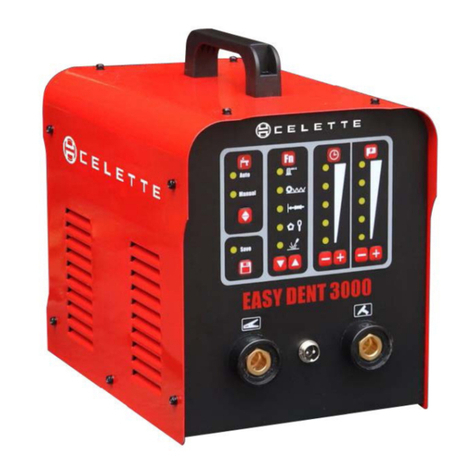
CELETTE
CELETTE EASY DENT 3000 Original manual

Viper
Viper 120 SYNERGIC operating manual

Clarke
Clarke weld MMA/TIG120 Operation & maintenance instructions
